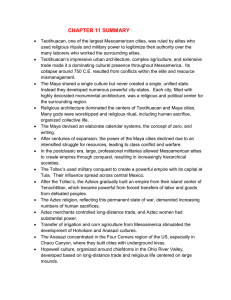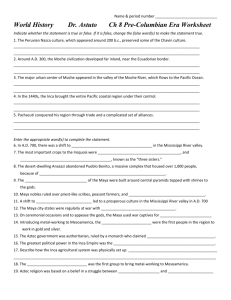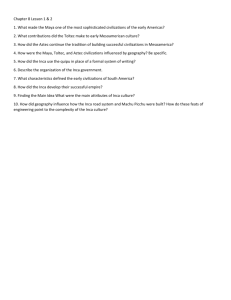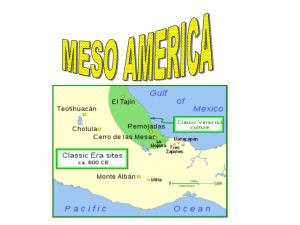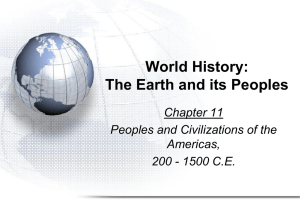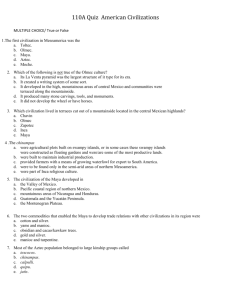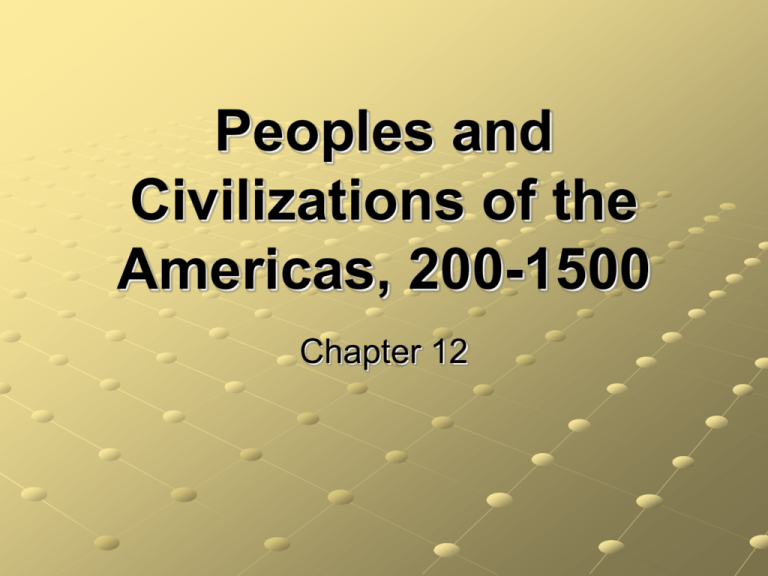
Peoples and
Civilizations of the
Americas, 200-1500
Chapter 12
Classic-Era Culture and
Society in Mesoamerica,
200-900
PGS 299-304
Teotihuacan
(teh-o-tee-WAH-kahn)
Teotihuacan was a large Mesoamerican
city at the height of its power in 450–600
CE.
The city had a population of 125,000 to
200,000 inhabitants
Dominated by religious structures
Pyramids and temples where human sacrifice
was carried out
The growth of Teotihuacan
Made possible by forced relocation of farm
families to the city
By agricultural innovations including
irrigation works and chinampas (“floating
gardens”) that permitted year round
agriculture
This increased food production and thus
supported a larger population
Chinampas
Apartment-like stone buildings housed
commoners, including the artisans who
made pottery and obsidian tools and
weapons for export
The elite’s increased status and wealth:
Lived in separate residential compounds
Controlled the state bureaucracy, tax
collection, and commerce.
Who controlled Teotihuacan
Appears to have been ruled by alliances of
wealthy families rather than by kings
The military was used primarily to protect
and expand long-distance trade and to
ensure that farmers paid taxes or tribute to
the elite
Reasons for Collapse of
Teotihuacan ?
Collapsed around 650 CE
The collapse may have been caused by
mismanagement of resources and conflict
within the elite
Invasion by a rival city
The Maya
The Maya were a single culture living in :
Guatemala
Honduras
Belize
Southern Mexico
They never formed a politically unified
state
Various Maya kingdoms fought each other
for regional dominance.
Mayan Agriculture
Increased their agricultural productivity by:
Draining swamps
Building elevated fields
Constructing irrigation systems
Mayan Religious Beliefs
The Maya believed that the cosmos
consisted of three layers:
The heavens
The human world
The underworld
The rulers and elites served as priests to
communicate with the residents of the two
supernatural worlds.
Maya military forces
Warfare was infused with religious
meaning and rituals
Fought for captives not for territory
Elite captives were sacrificed
Commoners enslaved
Mayan Women
Only 2 women ruled Maya kingdoms
Participated in bloodletting rituals and
other ceremonies
Held no political power; society was
patrilineal
Non-elite women probably played an
essential role in agricultural, textile
production and family life
Maya technological developments
Maya calendar
Ritual cycle (260 days—13 months of 20
days)
Solar calendar (365 days—18 months of 20
days plus 5 unfavorable days at years end)
Mathematics
Zero and place value
The Maya writing system
Whole words/concepts and phonetics
Decline of the Maya
Most Maya city-states were abandoned or
destroyed between 800 and 900 CE
Possible reasons for the decline of Maya
culture include:
The disruption of Mesoamerican trade
attendant upon the fall of Teotihuacan
Environmental pressure caused by
overpopulation
Epidemic disease
The Postclassical Period
In Mesoamerica, 900-1500
PGS 304-308
Toltecs
Borrowed from cultural legacy of
Teotihuacan
The most important Toltec innovations
dealt with politics and the military
Toltec Military
1st state based on military power
Extended power north of modern day
Mexico City to Central America
Tula, the capital city, was decorated with a
warlike theme (warriors, human sacrifice)
Toltec Political structure
Two kings ruled Toltec
Evidence suggests this led to the
destruction of Tula
One of the kings was exiled to the east
and after his exile, Toltec began to decline
1156 CE northern invaders destroyed Tula
Aztecs
The Aztecs were originally a northern
people with a clan-based social
organization
They migrated to the Lake Texcoco area
Established the cities of Tenochtitlan and
Tlatelolco around 1325
Developed a monarchical system of
government
Aztec Kings
The kings increased their wealth and
power by means of territorial conquest
As the Aztec Empire increased in size,
commoners lost their ability to influence
political decisions and inequalities in
wealth grew more severe.
Nobles lived in large two story houses and
consumed a rich diet
Aztec Agriculture
The Aztecs increased agricultural
production in the capital area by
undertaking land reclamation projects
(Lake Texcoco) and constructing irrigated
fields and chinampas
Grain and other food tribute met nearly
one quarter of the capital’s food
requirements
Aztec Trade
Specialized class of merchants controlled
trade and provided valuable political and
military information
Merchants were denied the privileges of
the high nobility
Bartered with the use of cacao, quills filled
with gold and cotton cloth
Aztec Worship
The Aztecs worshiped a large number of
gods (dual nature)
Most important God was Huitzilopochtli
(wheat-zeel-oh-POSHT-lee), the Sun god
Huitzilopochtli required a diet of human
hearts that were supplied by sacrificing
thousands of people every year
War captives were the preferred victims
Northern Peoples
PGS 308-311
Southwestern Desert Cultures
Most influential was the Anasazi (ah-nahSAH-zee) “ancient ones”
Anasazi developed a maize, rice, and
bean economy
Constructed underground buildings (kivas)
in the Arizona/New Mexico/Colorado/Utah
region around 450–750 CE.
The large Anasazi community at Chaco
Canyon had a population of about 15,000
people
They engaged in hunting, trade, and
irrigated agriculture
Chaco Canyon people seem to have
exerted some sort of political or religious
dominance over a large region
The Anasazi civilization declined in the
twelfth and thirteenth centuries as a result
of drought, overpopulation, and warfare.
Mound builders: Adena and
Hopewell
The Adena culture was based on hunting
and gathering supplemented by seed
crops
Around 100 CE the Adena culture blended
into the Hopewell society, located by the
Ohio River Valley
Early example of a chiefdom—territory that
had a population of as much as 10,000
and was ruled by a chief with both
religious and secular responsibilities
Mound Builders: Mississippian
Chiefs served as priests
Chiefs managed secular affairs such as
long-distance trade
The Mississippians built large mounds
both as burial sites and as platforms upon
which temples and residences of the
society’s elite were constructed
Cahokia
The largest Mississippian center was
Cahokia—population of about 30,000
around 1200 CE
Cahokia was abandoned around 1250,
perhaps because of climate changes and
population pressure
After their decline, smaller cities flourished
until the arrival of the Europeans
Andean Civilizations, 2001500
PGS 312-319
Andean Civilizations, Moche
The Moche culture emerged in the north
coastal region of Peru in about 200 CE
Moche used a labor system where clans
would have to provide a set number of
people each year for labor.
These people would work for religious
establishments, the royal court, or the
aristocracy
Moche society was stratified and
theocratic
Wealth and power was in the hands of an
elite group of priests and military leaders
They lived atop large platforms and
decorated themselves with magnificent
clothing, jewelry, and tall headdresses
Commoners cultivated their fields, cared
for their llama herds and supplied labor to
the elite
Moche artisans
skilled in the production of:
textiles
portrait vases
metallurgy
Gold and silver were used for decorative
purposes, copper and copper alloy for farm tools
and weapons
The decline and fall of the Moche civilization
may be attributed to a series of natural disasters
in the sixth century and to pressure from the
warlike Wari people in the eighth century
Chimu
The Chimu Empire began around 800 CE
Chan Chan was the capital city
Rulers separated themselves from the
commoners with rare textiles, ceramics
and precious metals
Believed to have a split inheritance: goods
and lands of the ruler went to secondary
heirs or for religious sacrifices while the
royal heir inherited the throne but was
forced to construct their own house
The Inca
The “Land of four corners”
The Inca were a small chiefdom in Cuzco
until their leaders consolidated political
authority and began a program of military
expansion in the 1430s
By 1525, the Inca had constructed a huge
empire.
Inca wealth
Ability to develop a strong professional
military
Used military in order to broaden and
expand the traditional exchange system
that had linked the various ecological
zones of the Andes region together
The Inca used their labor system to:
Man their armies
To build their capital city
To maintain their religious institutions
Provide for the old, the weak, and the ill.
Inca domination resulted in increased
wealth, but also in reduced levels of local
autonomy. When the elite fell into civil war
in 1525, Inca control over its vast
territories was weakened
Inca tunic
Inca tunic
Like the Aztecs, the Incas were a
small militaristic group that
established one of the most
extraordinary empires in the world.
Gradually, Inca culture spread
throughout Peru; roads built by the
Incas linked most of the Andean
region. Weavers in this region
produced beautiful textiles from
cotton and from the wool of llamas
and alpacas. The Inca inherited this
rich craft tradition and produced
some of the world's most
remarkable textiles. The quality and
design of each garment indicated
the weaver's rank and power in this
society. This tunic was an outer
garment for a powerful male.
Copyright © Houghton Mifflin Company. All rights reserved.

